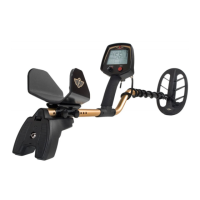Comprehensive Operating Manual & Guide to Metal Detecting
Comprehensive Operating Manual & Guide to Metal Detecting
6
43
F75
LIMITED
F75LIMITED
Assembly
1. Remove all components from box.
2. Attach
searchcoil to lower rod by
lining up the holes.
Push
coil knob through hole
and tighten knob gently.
You will tighten up the coil knob later.
3. Insert smallest rod into S-rod
(S-rod holds detector body).
Turn
top locking collar
counter-clockwise to open up.
Push in pin on small rod.
Slide small rod into upper rod.
Click pin into hole and tighten
locking collar firmly clockwise.
4. Push
lower rod into small rod
as follows:
Turn locking collar
counterclockwise to open up.
If plastic insert tab interferes,
push it down, or turn tube upside down.
Push in pin to allow rod to slide in.
Slide lower rod in.
Click pin into any hole.
5. Remove
velcro strip from lower rod.
6. Wrap
cable around stem as follows:
Leave some slack in cable at
base of lower rod.
Secure cable at base of rod with velcro strip.
Wrap cable loosely around entire
stem up to bent part of upper rod.
You will re-wrap the cable later
after sizing the rods to your height.
Cache Hunting
A cache (pronounced "cash") is an accumulation of
money, jewelry, gold, or other valuables, which someone
has hidden. When people bury a cache, they usually put
it in a strongbox or in a jar. To search for a cache, you first
need a reason to believe the cache may exist. This
means doing research. Some caches have been the
subject of many stories you can read about in print, but
you need to be able to sort fact from fiction. If you can get
copies of old newspaper stories about the circumstances
surrounding the hiding of the cache, you may find
discrepancies which help you to judge the reliability of the
information available. Often the best information on an old
cache is to be learned from old timers who live in the area
where the cache is thought to be. In the case of newer
caches, often the only information is what can be obtained
from family and acquaintances of the person who is
believed to have hidden the cache.
The ownership of a cache is not always clear. Sometimes it
belongs to the person or heirs of the person who hid it,
sometimes it belongs to the owner of the property on which
it is located, and sometimes it belongs to the person who
finds it -- or some combination of the above. If the contents
of the cache were stolen, this fact can also complicate the
question of ownership. Find out what laws apply to the
cache in question, and always make sure that the issue of
ownership is resolved prior to recovering a cache.
Compared to a coin, a cache is usually large and deep. Searching in Motion All Metal mode is
recommended. However, for a really deep cache, it may be advantageous to search in STAT
mode, frequently pulling the trigger momentarily to maximize sensitivity.
Shallow Water Hunting
All Fisher Research Labs searchcoils are waterproof, allowing you to search in shallow water
about two feet deep. If searching around water, be careful not to get the electronics housing
wet. Avoid salt spray, as it will work its way into the control housing and damage the
electronics -- such damage is not covered by the warranty.
Both fresh and saltwater beaches are popular places for metal detecting. Vacationers lose
money and jewelry playing in the sand and in the water. It is usually easy to dig in a beach
environment, and metal detecting is permitted on most beaches. Occasionally you may be
able to help someone recover a piece of jewelry they have lost minutes before; this is a
gratifying experience.
Detecting Activities (continued)
F75ltdBLK-MANUAL.qx6 12/22/11 4:15 PM Page 6

